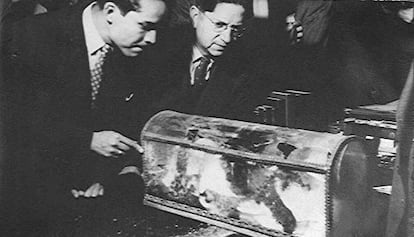The secret grave of Hernán Cortés
For 123 years, the Spanish conquistador’s final resting place remained a mystery


One of the biggest mysteries surrounding the life and legacy of Spanish conquistador Hernán Cortés has been his final resting place.
Between the 19th and 20th centuries, people thought his tomb had disappeared for good, which made it a favorite history topic in the Americas. Using fitting metaphors about Spain’s own ultimate destiny in Mexico, some said it had been looted while others affirmed that it was stolen long ago.
Using fitting metaphors about Spain’s own ultimate destiny in Mexico, some said it had been looted
Even today, as the conquistador’s grave site languishes in obscurity, his final resting place still holds surprises.
In 1823, following the Mexican War for Independence and with rampant anti-Spanish sentiment across the country, Lucas Alamán, who served as interior and foreign minister, came up with a plan to keep the tomb from falling into the wrong hands – and perhaps from even being destroyed.
According to historian Salvador Rueda, Alamán convinced many that the remains had been sent to Italy, when in fact he had hidden them under a wooden beam at the Hospital de Jesús Nazareno in Mexico City, which was built on the supposed spot where Cortés and Aztec emperor Moctezuma II met for the first time in 1519.
About 13 years later, the remains were placed behind a wall at the adjacent Purísima Concepción and Jesús Nazareno Church.
The hiding place was kept secret until 1843, when a burial act was filed at the embassy
The hiding place was kept under wraps until 1843, when Alamán filed a secret burial act with the Spanish Embassy in Mexico City with the hope that Cortés’s final resting place would never be forgotten.
The act was considered a classified document, and was guarded in the embassy’s safe for many years.
Cortés, the Medellin-born explorer who embodied the splendors and barbarities of the Spanish conquest of the Americas, was a forgotten man. Even mentioning his name was taboo in Mexico at that time.
No one cared about the whereabouts of his remains; Mexico was concentrating on more important things, such as forging its relationship with the United States.
Cortés was a forgotten man. Even mentioning his name was taboo in Mexico at that time
Then, in 1946, a top Spanish Republican government official, who was in exile in Mexico City and in charge of the embassy (Mexico had broken relations with the Franco nationalist government in 1939) released the secret burial act.
On November 28, 1946 Cortés’s remains were identified.
But even after 123 years, Cortés’s name could still cause controversy.
Many called for his remains to be thrown into the ocean, while others suggested more scandalous ways of getting rid of what was left of the barbaric Spanish plunderer.
During this heated public debate, Indalecio Prieto, the late PSOE leader, who served in the Republican government and was also living in exile in Mexico City, called for calm.
In a moving column published in the Mexican press, Prieto acknowledged the secret grave site but at the same time asked for reconciliation.
“Mexico is the only nation in America where anger stemming from the conquest and domination has not faded away. Let’s kill and bury this thing now by taking advantage of the wonderful opportunity,” he wrote.
But his words fell on deaf ears: Mexicans preferred returning Cortés’s remains to their original secret hiding place.
In 1947, they were again placed behind the wall left of the altar at Purísima Concepción and Jesús Nazareno Church, where they remain today.
“Do people stop by to visit?” this reporter asked the church’s secretary recently.
No one comes here. In fact, it is not permitted to take photographs or sight-see – we don’t allow that here”
“No one comes here. In fact, it is not permitted to take photographs or sight-see – we don’t allow that here,” she said, as she sat by the church’s entrance carefully watching anyone who entered or left.
The church, located on a busy avenue in the old part of the city, almost appears abandoned. There is old furniture piled on one side while scaffolding and bags line against the opposite wall.
From a mere distance, the tomb is not noticeable – there are no signs pointing in its direction.
But walking toward the end of the church and on the left hand side of the altar, an orange metal plaque placed about three meters above the floor can be seen. It reads: Hernán Cortés 1485 -1547.
Tu suscripción se está usando en otro dispositivo
¿Quieres añadir otro usuario a tu suscripción?
Si continúas leyendo en este dispositivo, no se podrá leer en el otro.
FlechaTu suscripción se está usando en otro dispositivo y solo puedes acceder a EL PAÍS desde un dispositivo a la vez.
Si quieres compartir tu cuenta, cambia tu suscripción a la modalidad Premium, así podrás añadir otro usuario. Cada uno accederá con su propia cuenta de email, lo que os permitirá personalizar vuestra experiencia en EL PAÍS.
¿Tienes una suscripción de empresa? Accede aquí para contratar más cuentas.
En el caso de no saber quién está usando tu cuenta, te recomendamos cambiar tu contraseña aquí.
Si decides continuar compartiendo tu cuenta, este mensaje se mostrará en tu dispositivo y en el de la otra persona que está usando tu cuenta de forma indefinida, afectando a tu experiencia de lectura. Puedes consultar aquí los términos y condiciones de la suscripción digital.
Últimas noticias
Reinhard Genzel, Nobel laureate in physics: ‘One-minute videos will never give you the truth’
Pinochet’s victims grapple with José Antonio Kast’s rise in Chile
From digital curfews to blocking apps: How technology experts protect their children online
Why the price of coffee has skyrocketed: from Brazilian plantations to specialty coffee houses
Most viewed
- Pablo Escobar’s hippos: A serious environmental problem, 40 years on
- Why we lost the habit of sleeping in two segments and how that changed our sense of time
- Trump’s obsession with putting his name on everything is unprecedented in the United States
- The Florida Keys tourist paradise is besieged by immigration agents: ‘We’ve never seen anything like this’
- Charles Dubouloz, mountaineering star, retires at 36 with a farewell tour inspired by Walter Bonatti








































